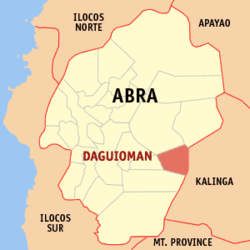Daguioman, Abra
| Daguioman | ||
|---|---|---|
| Municipality | ||
| ||
 Map of Abra with Daguioman highlighted | ||
.svg.png) Daguioman Location within the Philippines | ||
| Coordinates: 17°28′N 120°56′E / 17.46°N 120.93°ECoordinates: 17°28′N 120°56′E / 17.46°N 120.93°E | ||
| Country |
| |
| Region | Cordillera Administrative Region (CAR) | |
| Province | Abra | |
| District | Lone District of Abra | |
| Barangays | 4 (see Barangays) | |
| Government [1] | ||
| • Type | Sangguniang Bayan | |
| • Mayor | Salma Q. Padilla | |
| • Electorate | 1,291 voters (2016) | |
| Area [2] | ||
| • Total | 114.37 km2 (44.16 sq mi) | |
| Population (2015 census)[3] | ||
| • Total | 2,088 | |
| • Density | 18/km2 (47/sq mi) | |
| Time zone | PST (UTC+8) | |
| ZIP code | 2816 | |
| PSGC | 140105000 | |
| IDD : area code | +63 (0)74 | |
| Income class | 5th municipal income class | |
Daguioman, officially the Municipality of Daguioman (Ilocano: Ili ti Daguioman, Filipino: Bayan ng Daguioman), is a municipality in the province of Abra in the Cordillera Administrative Region (CAR) of the Philippines. The population was 2,088 at the 2015 census.[3] In the 2016 electoral roll, it had 1,291 registered voters.[4]
Geography
Daguioman is located at 17°28′N 120°56′E / 17.46°N 120.93°E.
According to the Philippine Statistics Authority, the municipality has a land area of 114.37 square kilometres (44.16 sq mi) [2] constituting 2.75% of the 4,165.25-square-kilometre- (1,608.21 sq mi) total area of Abra.
Barangays
Daguioman is politically subdivided into 4 barangays.[5]
| PSGC | Barangay | Population | ±% p.a. | |||
|---|---|---|---|---|---|---|
| 2015[3] | 2010[6] | |||||
| 140105001 | Ableg | 10.2% | 213 | 175 | 3.81% | |
| 140105002 | Cabaruyan | 23.9% | 500 | 412 | 3.75% | |
| 140105003 | Pikek | 19.6% | 410 | 313 | 5.27% | |
| 140105004 | Tui (Poblacion) | 46.2% | 965 | 815 | 3.27% | |
| Total | 2,088 | 1,715 | 3.82% | |||
Demographics
| Population census of Daguioman | ||
|---|---|---|
| Year | Pop. | ±% p.a. |
| 1939 | 596 | — |
| 1948 | 666 | +1.24% |
| 1960 | 1,003 | +3.47% |
| 1970 | 1,050 | +0.46% |
| 1975 | 1,124 | +1.38% |
| 1980 | 1,254 | +2.21% |
| 1990 | 1,413 | +1.20% |
| 1995 | 1,475 | +0.81% |
| 2000 | 1,748 | +3.71% |
| 2007 | 1,916 | +1.27% |
| 2010 | 1,715 | −3.95% |
| 2015 | 2,088 | +3.82% |
| Source: Philippine Statistics Authority[3][6][7][8] | ||
In the 2015 census, Daguioman had a population of 2,088.[3] The population density was 18 inhabitants per square kilometre (47/sq mi). Daguioman is the home of the Banao tribe of Itneg.
In the 2016 electoral roll, it had 1,291 registered voters.[4]
References
- ↑ "Municipality". Quezon City, Philippines: Department of the Interior and Local Government. Retrieved 31 May 2013.
- 1 2 "Province: Abra". PSGC Interactive. Quezon City, Philippines: Philippine Statistics Authority. Retrieved 12 November 2016.
- 1 2 3 4 5 Census of Population (2015). "Cordillera Administrative Region (CAR)". Total Population by Province, City, Municipality and Barangay. PSA. Retrieved 20 June 2016.
- 1 2 "2016 National and Local Elections Statistics". Commission on Elections. 2016.
- ↑ "Municipal: Daguioman, Abra". PSGC Interactive. Quezon City, Philippines: Philippine Statistics Authority. Retrieved 8 January 2016.
- 1 2 Census of Population and Housing (2010). "Cordillera Administrative Region (CAR)". Total Population by Province, City, Municipality and Barangay. NSO. Retrieved 29 June 2016.
- ↑ Census of Population (1995, 2000 and 2007). "Cordillera Administrative Region (CAR)". Total Population by Province, City and Municipality. NSO. Archived from the original on 24 June 2011.
- ↑ "Province of Abra". Municipality Population Data. Local Water Utilities Administration Research Division. Retrieved 17 December 2016.
External links
| Wikimedia Commons has media related to Daguioman, Abra. |
| Adjacent places of Daguioman, Abra | ||||
|---|---|---|---|---|
 |
Licuan‑Baay | Malibcong |  | |
| Bucloc | |
Balbalan, Kalinga | ||
| ||||
| | ||||
| Boliney | Pasil, Kalinga | |||
